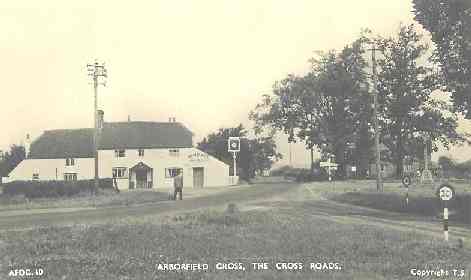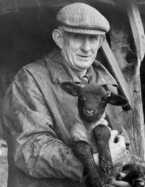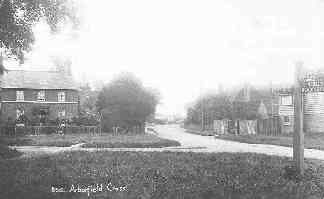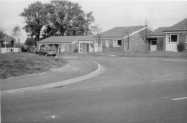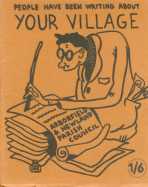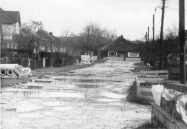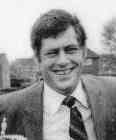
|
Arborfield
|
|
Parish Councils
Related sites:
See also: Arborfield Tithe Apportionment Map Newland Parish Council, 1894 - 1947 Arborfield Parish Council, 1894 to 1947 Martin Shearn's photos of Arborfield in the 1960's and 1970's Martin Shearn's postcards of old Arborfield Nicky Ford's postcards of old Arborfield
The Swan The effect of the Motorways on Arborfield and its surrounding area
|
After 1948, Arborfield and Newland became a single Parish Council, though the two had worked closely together during wartime. The first items dealt with by the new
Council were typical rural issues: footpaths, bus stops, preservation of trees,
village green, etc. - a true rural idyll. In recent times, the Councilís
business has been dominated by the A327 and traffic, Waste Transfer Stations,
housing development, Structure Plans, Transport Plans, Loddon Area Plans,
Housing Plans....... This article uses extracts from Minutes of the Annual Meetings, which effectively 'took the pulse' of the parish during this period of change up to the early 1980's, when there was a lull in large development for at least 15 years.
The 1948 joint meeting at the Village
Hall was well-attended with
60 present, because the new amalgamated Council was due to be elected. Ten
parishioners were proposed for the seven places, and none withdrew their
nominations, so a poll was held on 5th April, electing: By 1949, attendance at the Annual Meeting declined to 18. Concern was still expressed for improvements to roads and to provide footpaths for the safety of children. Electricity had finally been laid on by 1950,
but only to certain parts an The Councillors were busy in the following year, attending 10 Council meetings instead of the usual 4. A Public Meeting was
called in February 1951 to consider the findings of the Survey of Rights of Way,
and to record objections. The annual meeting in March was particularly
well-attended. Buses for schoolchildren would not be diverted, but Police would
supervise crossing the road near the bus stops. No fewer than nine sites had
been viewed f Domestic crises Mr A Jarvis took over the chairmanship in
1952
when Rev. Sparshott moved from the
He reported progress on getting
footpaths on parts of the A327 to what was described as an "interesting meeting"
of 28 people. At a Parish Council election on 9th May 1952, seven of the eleven candidates were successful: Mrs Capper, A special meeting was called in November 1952 to consider a house-to-house collection for the King George VI Memorial Fund, and for plans to celebrate the forthcoming Coronation. One suggestion was to put a rented television in the Village Hall for the villagers to view the ceremony. The 1953 meeting was told that the Parish
Cottages were becoming a liability
The new Council Houses [at Anderson/Emblen
Crescents] would not have garages on the ground of cost. Existing W.R.D.C.
tenants could now purchase their houses if they so desired. The final stage of
the survey of footpaths, bridleways and
Regarding bus stops, the southbound one near the Cross needed to be moved because 70 school children would all be waiting on a narrow section of path, preventing others from passing. Among other items, complaints were made about the "unpleasant odour emitting when the cesspool was emptied each week from the Bramshill Hunt into Wokingham Lane". Electricity for all? In 1954, people continued to complain about the lack of electricity for all and the lack of sewage facilities except for the new Council Houses. Victor Foxton was the new chairman; new business included a demand for a footpath along School Road, which was now a busy one; and for a telephone kiosk in Lower Arborfield [this was never provided]. The District Councillor reported each year on the progress made to reduce the housing list. By 1954, W.R.D.C. had built 715 Council Houses since the War, but in 1955 she had to report that the Council had only been allowed to build 50 that year. Council Houses 15 to 32 [those near the 'Bramshill Hunt'] were finally connected to Main Sewage and electricity by the 1955 meeting. When Norman Hart took over as chairman in 1956, he was able to report that some of the Parish Cottages were now improved: electricity was installed in those in Greensward Lane. However, those in Swallowfield Road were now condemned, and the tenants were now on the housing list. Walden Avenue was mentioned for the first time: because it was a private road, nothing could be done about the dangerous exit onto the main road [Walden Avenue was not yet surfaced]. The War Department had withdrawn their demands for extra ground for training purposes; these had included Kidgem's Copse and the Coombes. However, the Ducks Nest Farm area was to be used for minor tactical training. By 1957 the Council House waiting list had reduced to 550, 32 of them from Arborfield. 90 families had been housed in 1956/7, and 113 houses were under construction in Woodley. A further 300 were planned throughout the Rural District, and it was anticipated that the waiting list would dwindle to nothing within another year. There were no members of the public at the 1957 meeting, while only one attended in 1958, where it was reported that the Parish Cottages in Swallowfield Road were about to be demolished, now that Mrs Hawkins had been re-housed "in the Newlands Estate". In 1959, the state of the old churchyard was again discussed. It could not be cleared until existing buildings which were considered unsafe were demolished. Four more houses in the village had been condemned, and the tenants needed to be re-housed. Mr Beton asked if footpath No. 16 be closed because it ran to School Road through the planned estate adjoining the British Legion; a new road [Link Way] linking with the Newlands Estate would render it unnecessary. Despite the fond hopes of W.R.D.C. a couple of years earlier, the Council House waiting list had not shrunk by 1959 after all; at that time, there were just over 600 on the list, 31 of them from Arborfield. School Road was finally provided with a footpath by 1960. The new chairman, Guy Bentley, listed the village organisations, including the W.I., the Young Wives' Group, the 60-strong Gardening Association and a popular weekly Whist Drive organised by Miss Smith for funds for a summer outing for the Old Age Pensioners. However, the Royal Observer Corps only had 7 members, and was in danger of disbanding. Mr. Bentley said that "they would face an impossible task should hostilities ever break out again. One does not realise that these men train not only for aircraft recognition, but also for radioactive fallout which would endanger the lives of all should ever a nuclear [strike] occur". The District Councillor reported that several local people had been housed, some locally and some in Woodley. "The R.D.C. recognise that the housing problem was acute in Arborfield, but there is no land available for building; also, that there are a number of under-populated houses in the village". [This problem would persist for another decade until new bungalows were built in three new locations - Whitewell Close, Harts Close and the civilian part of Valon Road]. A Dormitory Village? Mr Bentley said the following year that, if ever the progress of this parish were written, 1960 to 1961 would be recorded as the year in which the character of Arborfield and Newland experienced the greater alteration. The two new housing estates [Link Way and Melrose Gardens] were bringing a different atmosphere to the village. Where in years gone by the main livelihood was derived from agriculture, now the parishioners consist of civil servants, engineers, aircraft workers and many others. The demolition of the Post Office Cottages would, no doubt, result in a useful addition of new houses to the village, and it was hoped that the new buildings would be erected to fit in with the character of the Village Street and surrounding buildings. The vacant site opposite the Bull was to be purchased by the County Council for road improvements. The 1962 meeting was told that the Greensward
Lane cottages were now condemned; the tenants would be re-housed and the land
sold. The Old Pond site was still an eyesore, being cut up by parking heavy
vehicles; however, the War Memorial and surrounds were being very well-kept by
Mr Clacey. T Land behind the Village Stores had been sold for development [this land became the extension of Melrose Gardens beyond the footpath to Arborfield Court]. Parts of the main street were still not connected to main drainage. Eight members of the public were present in 1963 to hear that the Playing Fields Association had levelled and seeded the site at the British Legion, and it was now available for use by football teams. Any parishioners interested in forming a bowls or tennis club were to contact the Secretary of the PFA. Ernest Mann took the chair in 1964, when Link Way was first mentioned by name: its residents complained of the terrific speed used by cars and other traffic along it, because there was no speed limit. The green in Anderson Crescent was being chewed up by cars being parked on it, there being no garages for them. Worse, the footpath path from Eversley Road to Anderson Crescent was dangerous because of cyclists, and it 'was often being used immorally also as a urinal'. The
At this stage, Melrose Gardens opened onto Swallowfield Road, but it would be
More development was planned for 12 old peoples' flats on land next to Magnolia Cottage, plus 18 flats on the same site [this became Whitewell Close]. Sadly, Ernest Mann had to report that three former Councillors had died: Miss Jervoise of Targett's, Mr Norman Hart formerly of Emblen Crescent, and Mr Guthrie Allsebrook formerly of Arborfield Hall, who'd moved a few years before to Shinfield. "Your Village" A Village Book was planned in 1966 to help make newcomers welcome. Main drainage and sewage pipes in the centre of the village were about to be commissioned. The Council were concerned about the dangerous road junction at the Cross, suggesting a roundabout and also the re-siting of the Bull! At the other end of the village, there were dangerous bends near the Bramshill Hunt, and there had been several accidents at the Langley Common Road junction, with cars ending up in the ditch. Street lighting was a contentious issue, 81 in favour but 73 against. A compromise was that lights would be erected on the new estates, but that the main road and Church Lane would not be lit. Plans were in hand to buy children's play equipment for the British Legion site. 11 parishioners at the 1967 meeting heard about plans to improve grass areas around the Cross now that the estate was complete. The developers [Weaver] were to be pressed to ensure that trees were planted as promised. Main drainage might at last come to Walden Avenue, Church Lane and Greensward Lane. Electricity supply was a problem: "Arborfield is subjected to a large number of electric cuts which causes a great deal of hardship". A footpath was considered alongside Hillcrest, when funds allowed. The vacant land next to the Post Office was overgrown and an eyesore, accumulating rubbish; likewise the land between Hillcrest and Melrose Gardens [now Harts Close].
The land at Greensward Lane where the former Parish Cottages stood would be sold with planning permission for two new houses. Mr Harlow asked if Walden Avenue was to be made up when Main Drainage was complete, while Mrs Prentice had heard that it was 22nd on the list for the County. However, the meeting as a whole considered that the Arborfield Cross junction was the main priority. A footpath may be provided adjacent to Cross Lanes Farm. The possible reason for the crowded meeting was the discussion of speed limits, led by Messrs. Adams, Anderson, Arkell, Attwood, Mann, Mason, Capt. Meaby and Mrs Berry. Annual Reviews begin
The new by-pass was under construction in 1970, when parishioners learned with alarm that the Eversley Road would be cut off through the camp in conjunction with the new Army housing developments. Plans were well advanced to extend the Village Hall, which had been talked about for years. Other plans to provide more shops in the village were stagnating. The school head, Cyril Piggott (who had been a Parish Councillor and active in many organisations) had moved from the village, and was replaced by Leslie Vokes.
1971 w The new Infants' School was nearing completion. The British Legion had given the Playing Fields Association notice to quit the site as the lease was running out. The Council were beginning to look elsewhere for a site, perhaps further behind the British Legion. The meeting, provoked "lively discussion", including very popular proposals to acquire (rather than lease) a 10 acre site. The scope of the Hurst Fuel Allotment which was administered by the Council was broadened. A request was made for a footpath from the Cross along Sindlesham Road to its junction with Church Lane. Melrose Gardens residents complained of low water pressure. The 1972 meeting generated a huge crowd of about 100 parishioners plus the entire Council. The recreation ground was likely to be off Swallowfield Road, but the land owner [Herbert Lee of Newland Farm] did not wish to sell; a compulsory purchase order would be required. The meeting was asked to approve a £12,000 loan for the development (49 for, 23 against). Further Housing Developments and the By-Pass By 1973, the Hillcrest development [Harts
Close] was completed, and a landscaping scheme was proposed to alleviate the
harshness of the elevations, which were more prominent than expected.
Landscaping of the Garrison by-pass included 29 trees planted by parishioners.
The Fuel Allotment generated very little income: £9 was enough to cover only 5
lots of 2 cwt in December 1972. The cost of the Recreation Ground had risen to
£17,000. The cul-de-sac formed by the Garrison by-pass was still known as Eversley Road, which caused confusion. Residents did not want the name to be "Eversley
Close".
69 parishioners attended the 1974 meeting, chaired by Noel Sudbury. They heard that the Recreation Ground site had been acquired in September 1973 and was being seeded, but would not be ready until 1975. Speed limits and sight-lines continued to cause complaint, and a traffic warden had been allocated to the village. Mini-roundabouts had been proposed by the Parish Council (but rejected by the County) for the five-way junction at the Cross, and the Council were maintaining a record of all traffic accidents to be used as evidence of need. The 1975 meeting was reminded that Arborfield had won the "Best-Kept Village" competition at the first attempt. The recreation ground was to be opened on 10th May with a celebration, and volunteers had planted donated trees. A pavilion was to be built out of the rate levy. The recreation ground would be called "Arborfield Park" (11 votes) in preference to "Causeway Park" (7 votes) , "The Arbor" (5 votes) or four other suggestions (12 votes combined). There was a planning appeal against refusal to allow development of 28 flats at the site of Newland House. The site of Newland House continued to generate heat at the 1976 meeting, as well as from the burning of tyres and cables which was a continuing nuisance. Planning permission had been granted for building 19 flats, though the Parish Council objected to the design. Fred Fox announced that, arising out of the 1975 Park celebrations, the Arborfield Entertainments Committee had been formed, initially providing a regular disco. The Pavilion was complete and in use by 1977. Edition 4 of "Your Village" had been published and distributed. There was a spate of vandalism, with new trees being broken. Travellers . . . 'Travellers' were a problem in 1978, having occupied verges off Langley Common Road. Among other topics mentioned, Peter Teague of the Park Management sub-committee reported that the football pitches were well-used and that the car park was now surfaced with tarmac. 34 parishioners attended in 1979. The chairman reported that Anderson and Emblen Crescents now had street-lights, and that Berks County Council planned to illuminate the A327 from Shinfield to Langley Common Road. A drainage scheme had been completed at the Park. Fuel allotments were down to 2 lots of coal that year. Andrew Harbinson reported that the Arborfield Village Association had been formed to replace the Entertainments Committee, aiming eventually to provide a social centre large enough to cater for the needs of the village. There was a proposal in 1980 to amalgamate Arborfield and Newland with Barkham Parish Council in 1983 together with boundary changes at Bearwood, Nash Grove Lane and Doles Lane. Pound Copse was finally to be handed over, in exchange for the removal of a stub footpath.
The bus service from Reading via Arborfield had been axed, but the council won a reprieve for a much reduced service to be provided between Arborfield and Wokingham. The Schools Association had provided a cover for the swimming pool.
[Further summaries of Annual Meetings
will be recorded here after passage of a little more time....]
|
||
|
Any Feedback or comments on this website? Please e-mail the webmaster |
